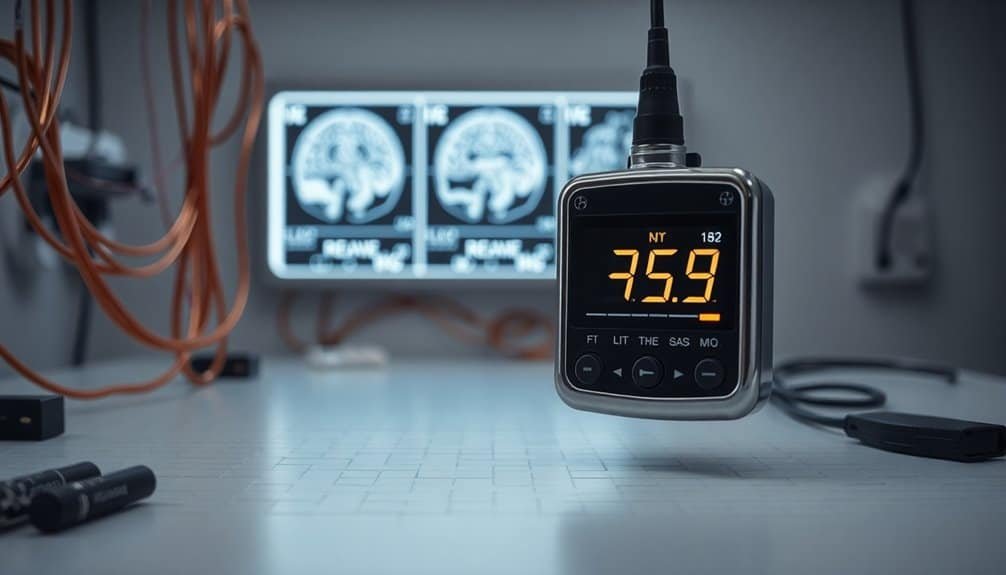EMF and Alzheimer’s Disease / Dementia
EMF exposure, encompassing electromagnetic radiation from devices like cellphones and power lines, is linked to a complex relationship with Alzheimer’s disease and dementia. Research suggests that long-term exposure to extremely low frequency (ELF) electromagnetic fields may elevate Alzheimer’s risk, especially in men.
Conversely, some studies indicate that certain EMF types can improve cognition and decrease amyloid-beta levels in animal models. Further investigation into specific frequencies and treatment applications is necessary to fully understand these effects.
Disclaimer: As an affiliate, I may collect a share of sales from the links on this page.
Understanding EMF Exposure

What exactly is electromagnetic field (EMF) exposure, and why is it important? EMF exposure refers to the electromagnetic radiation emitted from various sources like power lines, appliances, and wireless devices.
There are two types: non-ionizing EMFs, generally considered harmless, and ionizing EMFs, which can cause DNA damage. EMFs are categorized into extremely low frequency (ELF) and radiofrequency (RF) fields.
Common household appliances, such as kitchen tools and hair dryers, generate ELF exposures, while cellphones and laptops produce RF-EMFs. Understanding exposure levels helps assess potential health risks, like a suggested weak link between ELF exposure and childhood leukemia, necessitating ongoing research. Current scientific evidence does not link cell phone use to adverse health issues, although ongoing research is necessary to assess long-term effects of EMF exposure from modern technology.
Relationship Between EMF and Alzheimer’s Disease
As researchers explore deeper into the potential connections between electromagnetic field (EMF) exposure and Alzheimer’s disease, they uncover intriguing patterns and associations.
Long-term exposure to extremely-low-frequency magnetic fields (ELF-MF) considerably raises the Alzheimer’s risk in men, showing relative risks of 2.3. Remarkably, this effect appears gender-specific, with no significant association detected in women. Recent studies indicate that Aβ expression changes may also play a critical role in understanding the relationship between EMF exposure and cognitive decline.
Studies suggest a dose-response relationship; higher ELF-MF exposure correlates with increased risks. However, mixed findings emerge from various studies, leading to inconsistent conclusions. Some cohort studies indicate no substantial evidence linking EMF exposure to Alzheimer’s, resulting in a lack of consensus on this complex relationship.
Cognitive Benefits Observed in Animal Studies

Research reveals that long-term exposure to electromagnetic fields (EMF) can lead to cognitive enhancements in various animal models, particularly those simulating Alzheimer’s disease. Transgenic mice commonly serve as subjects, allowing researchers to assess EMF’s impact on cognition.
Studies often employ specific frequencies and intensities, such as 918 MHz and 0.25 W/kg, to evaluate cognitive benefits.
- EMF exposure shows potential in reducing amyloid-beta deposition.
- Animals perform better on memory-related tasks after EMF exposure.
- Enhanced cerebral blood flow may contribute to these cognitive improvements.
- Recent studies indicate significant behavioral changes observed in rats exposed to EMF also highlight the potential influence on neurological functions.
These findings invite cautious interpretation regarding their applicability to human conditions.
Mechanisms Behind EMF Effects on the Brain
Understanding the mechanisms behind EMF effects on the brain involves examining various biological processes influenced by electromagnetic fields.
RF-EMF exposure may increase blood-brain barrier (BBB) permeability, causing albumin leakage. This variability in outcomes points to uncertainty in mechanisms.
Additionally, RF-EMFs can induce oxidative stress, leading to potential brain tissue damage and neurodegenerative implications.
ELF-EMFs have been shown to enhance neurogenesis and neuronal plasticity, which might offer therapeutic avenues.
Furthermore, altering brain functional connectivity occurs with RF-EMF exposure, potentially impacting cognitive functions.
Each of these mechanisms provides insights into how EMFs affect brain health and function.
Impact on Amyloid-Beta and Tau Proteins

The impact of electromagnetic fields (EMFs) on amyloid-beta (Aβ) and tau proteins is a critical area of investigation, given their roles in Alzheimer’s disease progression.
EMF exposure affects Aβ levels and aggregation notably:
- Repeated electromagnetic field stimulation reduces Aβ40 and Aβ42 secretion without invasive methods.
- High-strength oscillating fields disaggregate amyloid peptides, preventing re-aggregation.
- Enhanced neuronal activity after EMF exposure may improve Aβ clearance from the brain.
These findings suggest that EMFs could serve as a noninvasive therapeutic approach for targeting amyloid-beta pathology, potentially delaying disease onset and progression while minimizing cellular damage related to treatment efforts.
Human Studies and Data Limitations
Human studies examining the effects of electromagnetic fields (EMFs) on Alzheimer’s disease exhibit significant data limitations that complicate their findings.
For instance, smaller sample sizes, like the 42 twin pairs discordant for dementia, often lack statistical significance. Additionally, many studies fall short in long-term follow-up, preventing assessment of chronic EMF exposure effects.
Variability in EMF exposure measurement methods leads to inconsistent results, while a focus on specific occupations restricts generalizability. Confounding variables, like lifestyle and genetics, make isolating EMF impacts difficult.
Consequently, replication studies are essential to verify results and understand the complexities surrounding EMF exposure and dementia risk.
Risk Factors Associated With EMF Exposure
Research indicates that specific risk factors are associated with electromagnetic field (EMF) exposure, particularly concerning Alzheimer’s disease (AD). Long-term exposure, especially in occupations with higher electromagnetic field (EMF) levels, may increase AD risk.
Key points include:
- Occupational Exposure: Jobs like seamstressing can elevate risks due to medium to high EMF exposure.
- Gender Differences: Men show more pronounced associations than women, likely due to exposure misclassification.
- Dosage Impact: Higher EMF levels correlate with increased risks of AD, supporting a dose-response relationship.
Additionally, understanding the effects of EMF radiation on health is essential for mitigating potential risks associated with EMF exposure in your environment.
Future Directions for Research
Emerging as a critical area in Alzheimer’s disease research, future directions for exploring the effects of electromagnetic fields (EMF) present exciting possibilities.
New biomarkers are being developed to accurately track cognitive decline. Investigations into electromagnetic field technology show potential in targeting amyloid beta and tau protein aggregates.
Additionally, neurostimulation devices may reduce Aβ levels, possibly affecting disease progression. Research indicates that varying EMF frequencies yield different impacts on Alzheimer’s pathology.
Human clinical trials, especially randomized controlled trials, are essential to validate therapeutic benefits. Interdisciplinary collaboration will enhance understanding, while global networks can accelerate advancements in EMF research for Alzheimer’s.
Potential Therapeutic Applications of EMF
While researchers continue to investigate alternatives to traditional Alzheimer’s disease treatments, electromagnetic field (EMF) therapy shows promise as a viable option. EMF can modify gene expression linked to Alzheimer’s, stimulate tissue regeneration, and target amyloid pathways.
Clinical trials highlight its potential therapeutic applications, emphasizing:
- FDA-cleared PEMF devices for usage in neurological conditions.
- Neurostimulation benefits targeting specific brain areas to enhance neuroprotection.
- Non-pharmacological approaches, representing a shift in managing AD pathology.
As evidence accumulates, EMF therapy might revolutionize treatment strategies, providing new hope for Alzheimer’s patients through innovative mechanisms and therapeutic interventions.
Integrating EMF With Current Alzheimer’S Treatments
Integrating EMF with current Alzheimer’s treatments presents a unique opportunity to enhance patient outcomes.
Research indicates that pulsed electromagnetic fields (PEMF) can improve cognitive function in Alzheimer’s patients. Neurostimulation devices target neural circuitry and amyloid pathways, showing promise in non-pharmacological approaches.
The EVOKE study demonstrates PEMF’s safety and efficacy over 120 days. EMF devices may modulate neuronal activity and promote beta-amyloid degradation.
Combining EMF with existing pharmacological therapies could enhance efficacy and reduce side effects. Future research must focus on optimizing EMF parameters, ensuring patient safety, and establishing clinical guidelines for effective integration into treatment protocols.
Frequently Asked Questions
Can EMF Exposure Cause Other Neurological Disorders Besides Alzheimer’S?
You may wonder about EMF exposure’s potential links to various neurological disorders. Emerging evidence suggests it could influence conditions like ALS and Parkinson’s, but research is still ongoing, and definitive conclusions aren’t established yet.
Are There Any Personal Protective Measures Against EMF Exposure?
You can reduce EMF exposure by keeping devices away from your body, using speakerphones, avoiding microwaves, and wearing protective clothing. Limiting call durations and using text messaging also helps enhance your safety.
How Does EMF Exposure Affect Different Age Groups?
Did you know younger people are more exposed to EMFs daily than ever before? EMF exposure affects age groups differently. Children’s developing brains are more vulnerable, while the elderly face cognitive decline and immune system challenges.
Are Certain Technologies More Harmful Regarding EMF Radiation Levels?
Yes, certain technologies emit higher EMF radiation levels. Cell phones and smart meters typically present more risk than Wi-Fi or Bluetooth devices. Considering exposure duration and proximity is essential for minimizing potential harm to you.
What Lifestyle Changes Can Mitigate Potential Risks From EMF Exposure?
You can create a vibrant lifestyle by stepping back from screens, savoring antioxidant-rich foods, enjoying nature walks, and establishing tech-free zones. These simple adjustments can refresh your well-being and nurture a healthier home environment.
Conclusion
EMF exposure is a complex and evolving field of study, particularly regarding its potential link to Alzheimer’s disease. Some animal studies suggest cognitive benefits, but mechanisms remain unclear.
Research highlights the impact of EMF on amyloid-beta and tau proteins, critical factors in dementia. As investigation continues, integrating EMF into Alzheimer’s treatments might hold promise.
Think of EMF as a tool, potentially revealing new paths in addressing this formidable condition. The future awaits exploration.






